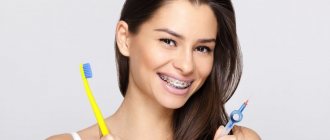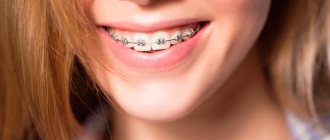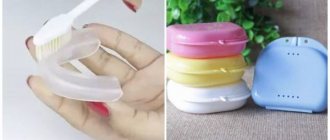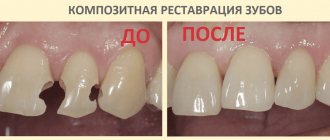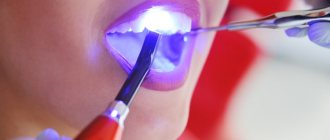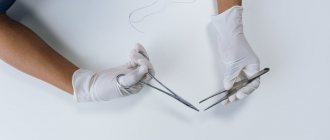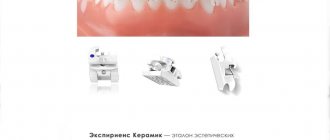Those who have just had braces installed may experience discomfort and pain in the first few days or weeks. This is a normal adaptation process, after which the discomfort will subside. Wax for braces helps minimize discomfort. We’ll tell you in the article how to use it and what to replace it with.
In this article
- Braces design
- Why do you need dental wax with braces?
- Composition of orthodontic wax
- How to use wax for braces?
- How can you choose wax for braces?
- What can replace wax for braces?
- How long to use dental wax?
All about braces care
- How to care for braces after installation?
- Minimum contents of a braces care kit
- Basic rules for caring for teeth with braces
- What braces care products do orthodontists recommend using?
- Orthodontic wax and irrigator: additional elements of the standard set
- Features of caring for sapphire braces
The procedure for straightening teeth and correcting bite is considered one of the longest and most difficult in dental practice. The bracket system is quite expensive, and without regular maintenance it will require replacement before the end of its intended service life. That is why it is necessary to strictly adhere to hygiene rules and do not forget to clean your braces daily.
Of course, there is always a risk of physical damage to an expensive structure due to an impact, but much more often the consumption of “forbidden” food leads to deformation. Any sticky or hard foods should be completely excluded from the diet. Taffy, caramel and chewing gum are especially dangerous. Tiny particles can get behind structural elements and begin to attract the remains of other food. Over time, plaque forms behind the ligatures.
Are there any contraindications
The wax used in orthodontic practice has a completely safe composition, and therefore is characterized by a minimum number of contraindications. Many people are interested in the question of whether it is possible to sleep with it. Because it is non-toxic, it does not need to be washed off before bed if your braces become chafed while you sleep.
In some cases, the use of this product is not recommended, mainly due to increased sensitivity to individual components included in the composition. Otherwise, the risk of developing an allergic reaction will increase, which can be expressed in the form of itching, swelling, redness of soft tissues and the development of an inflammatory process1. If you observe something similar in yourself, stop using the composition and consult a dentist for advice on eliminating symptoms.
How to care for braces after installation?
A professional orthodontist must teach his patient how to properly clean the braces. Teeth under dirty metal structures can deteriorate very quickly, so it is necessary to pay attention to oral hygiene on a daily basis. Caring for braces after installation involves thoroughly removing plaque and (if possible) disinfecting metal elements. An electric toothbrush with special attachments will do the best job of cleaning orthodontic arches, rings and ligatures. Alternatively, you can purchase a regular brush with medium-hard artificial bristles.
First of all, you need to remove the removable rubber bands and thoroughly brush your teeth, then place the brush at an angle of 45 degrees to the jaw. The bristles should completely cover the ligature. You need to spend at least ten seconds on each tooth. In order to clean the braces from the inside of the jaw, you will need a special V-shaped single-tuft brush. After all the metal elements are perfectly clean, you need to take a special wax and lubricate all the places where the braces come into contact with the mucous membranes (including the interdental space). For greater convenience, you can use a special thin brush.
What are the pros and cons
Before we figure out how to use wax correctly, let’s outline its main advantages. According to numerous patient reviews, the protective agent in question has a whole list of important advantages:
- protects the oral mucosa from mechanical injury,
- prevents the occurrence of scratches and ulcers, irritation and inflammation,
- reduces the duration of the adaptation period, helps to avoid unpleasant sensations,
- Some brands offer products with aromatic additives to choose from,
- to some extent allows you to improve the appearance of the iron structure, since after rubbing the protruding elements with wax, they will become less noticeable from the outside,
- the composition is completely harmless, does not provoke allergy attacks,
- vacuum packaging prevents contamination of the wax with dust,
- ease of use, does not require specialist participation,
- affordable price.
Wax can protect the mucous membrane from injury.
As with any other product, there is a risk of stumbling upon low quality. Such a product will quickly wash off and become loose under the influence of saliva. It is recommended to remove the wax before eating. If the patient has a tendency to allergic reactions, it is better to give preference to a product without fragrances.
Minimum contents of a braces care kit
Careful oral hygiene is an integral part of caring for your braces. After installing an orthodontic device, you will have to brush your teeth not only in the morning and evening, but also after every meal. You will need a whole arsenal of accessories and special products in order to provide complete care for teeth with braces. The minimum required is:
- V-shaped toothbrush;
- toothpaste;
- waxed dental floss;
- floss toothpicks, or interdental brushes,
- monotuft brush;
- pocket mirror.
It is best to purchase a ready-made orthodontic kit. A braces care kit usually comes with a cosmetic bag or a small plastic box. This kit is very convenient to carry with you and can be used after every meal, even outside the home.
Give preference to proven and popular brands
Typically, wax is purchased from the dentist where the braces were installed. It can also be purchased in pharmacies and online stores. Below we present to your attention the most popular, inexpensive, economical options, according to customer reviews:
- PresiDENT L'industria Zingardi (Italy): the package contains 7 strips of tasteless and odorless wax. According to reviews, it holds well and does not dissolve for a long time. Cost – from 180 rubles,
- Ortho Performance (USA): the manufacturer of this product offers a whole line of flavors for pleasant application and fresh breath - orange, pineapple, candy, strawberry, mint. There are 5 plates in the package. Price – from 120 rubles,
- Dentaid Vitis Orthodonic Wax (Spain): with a soft texture. You can choose unscented, or you can choose apple or mint flavor. The package contains several sealed cases with five strips in each. Cost – from 300 rubles,
- Revyline (Russia): you can choose unscented, or with the aroma of chewing gum1, watermelon or orange. The kit includes a convenient reusable case and 5 strips of wax. Price – from 130 rubles,
- GUM (USA): has a dense texture, with vitamin E and Aloe Vera. Price – from 400 rubles per package, which contains 5 plates.
Give preference to proven and popular brands
Basic rules for caring for teeth with braces
As mentioned above, proper care of the braces system begins with brushing your teeth. Using circular movements, it is necessary to clean each tooth from the outside and back. When using an electric toothbrush, it is strictly forbidden to press the head too hard against metal elements. This risks causing the bristles to break out and get stuck in the ligatures.
Next, you need to use a floss toothpick or a special brush to remove plaque from the interdental spaces. But to remove food debris directly from under the braces, waxed dental floss is suitable. To clean, you need to tear off about 30 centimeters of thread and carefully insert it under the staple. Then pull the thread under the rings and holes in the locks and make several cleaning movements. Repeat the procedure with each tooth. Next, you can begin to carry out the above-described care program directly for braces, after rinsing your mouth with salt water or a special solution.
What braces care products do orthodontists recommend using?
As for toothpaste, it is better to give preference to one that contains fluoride and xylitol. You can also choose a mouthwash with a similar composition. Fluoride will help prevent tooth decay, and xylitol will protect against bacteria and germs. Also, xylitol-based products leave a pleasant feeling of coolness, which allows you to forget about the presence of iron braces in your mouth for a while.
As for home remedies, dentists recommend using plain salt water as a rinse. Rapa will quickly relieve pain, which often occurs in the first month after installation of the system, and will also destroy bacteria in the oral cavity. Salt water will help heal sores and cuts that may appear on the gums or the mucous membranes on the inside of the cheek. To prevent damage to mucous membranes, it is better to use professional braces care products.
How long to use dental wax?
Wax should be used as needed. If the structure in the mouth causes discomfort, you can apply the composition at least every day for a month. If after two days of using wax the discomfort has passed, the mucous membrane has adapted to braces, and ulcers no longer form, you don’t have to apply wax. Practice shows that wax compositions are most often used by beginners during the period of getting used to braces. Those who have been wearing orthodontic structures for a long time often use wax when the arch breaks or the lock comes off.
In any case, it is advisable for a patient undergoing orthodontic treatment to have dental wax in his medicine cabinet. It will make the treatment process more comfortable and safe.
Orthodontic wax and irrigator: additional elements of the standard set
The use of orthodontic wax can significantly reduce the discomfort caused by metal braces.
Very often, protruding elements of the braces system scratch the delicate tissues of the oral cavity. Wax protects gums, inner lips and cheeks from sores and scratches. The wax is sold in small plastic boxes and has a structure similar to soft chewing gum. Using the product is quite simple: you need to tear off a little wax from the container, warm it in your palms, and then apply directly to the lock or bracket that is causing irritation. Don't worry that some of the wax will be accidentally swallowed, because dental products are non-toxic. Another optional, but very useful device designed to make caring for braces easier is an irrigator. This dental device is used to clean the spaces between braces and teeth. The irrigator acts as a small pump that directs a stream of water to the desired location.
Is it possible to put braces on only one jaw?
Many patients are perplexed: why, if, for example, 1-2 upper teeth are displaced, why install a system on the entire jaw. The desire to minimize inconvenience and costs is quite understandable, but the realities are different: teeth are straightened not by braces, but by the device that is attached to them, and the force of its influence must be uniform, which requires fixation on the entire dentition. Otherwise, the “crooked” tooth will fall into place, but will inevitably push others out of the row.
The concept of a “partial bracket system,” however, exists - such systems are installed on one jaw and cost half as much. However, such a correction is possible only in the absence of bite pathologies and strict symmetry of the teeth of the upper and lower jaws, when there is only a slight curvature of 1-2 teeth (according to statistics, in orthopedic practice there are no more than 5% of such cases).
What toothbrushes should you buy to care for braces?
For complete care, one v-shaped brush is not enough. In order to be sure that the teeth under the braces system are perfectly cleaned, you need to have several more types of brushes in your arsenal.
Interdental.
This type is used to clean spaces between brackets as well as areas under metal arches. Interdental brushes are available in different sizes, so they can also be used for deep cleaning of interdental spaces.
Mono-beam.
The mono-beam brush has a curved shape, thanks to which it can reach even the most difficult to reach places. This type of brush is intended for caring for braces, not teeth. Even the smallest clasps and ligatures will be perfectly clean with daily use of mono-tuft brushes.
It is worth knowing that any type of brush will wear out several times faster. This is due to the fact that when cleaning a metal system, the bristles can be pulled out. Therefore, you will have to change all care accessories much more often than recommended on the package.
Compound
The composition of the plates includes components of organic origin with a neutral effect. The main substance of this material is natural wax with silicone additives.
Many products are flavored with additives of fruit, flower and other aroma of natural origin. The most popular are records with mint, raspberry, anise, and orange flavors.
Sometimes product manufacturers add anti-inflammatory components to the composition, which promote rapid healing of wounds and inflamed areas of the mucous membrane.
Features of caring for sapphire braces
Adult patients prefer polymer materials to metal that is too visible. Sapphire braces are transparent, lightweight and ultra-thin, which allows you to avoid drawing unnecessary attention to your smile. In general, caring for sapphire braces is practically no different from the above rules. However, orthodontists recommend remembering several important nuances. Firstly, it is forbidden to smoke, drink tea and coffee in large quantities. Violating this rule will result in expensive transparent braces acquiring a yellowish tint. You will also have to rinse your mouth not twice a day, but after each meal. After all, any dirt stuck behind the ligatures will be visible to others.
We must not forget that the polymer material is quite fragile. Orthodontists recommend purchasing a special protective mouthguard, which must be worn whenever active sports are planned.
If you adhere to all the above rules, then you don’t have to worry about the condition of your teeth after removing braces.
